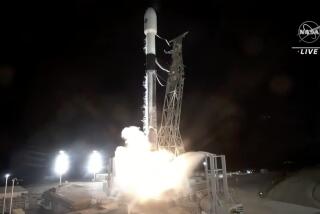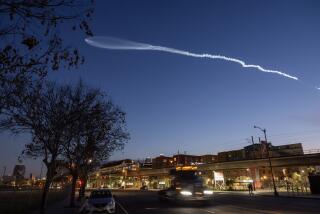Secrecy was crucial in missile test launch that rattled L.A., experts say
Southern California is now well aware of the “light” in the sky that caused so much discussion Saturday night: It was an unarmed Trident II (D5) missile test flight off the coast.
The test was top secret, and the military has released relatively little information. But officials acknowledged they didn’t anticipate the brightness of the launch -- and the public reaction.
Was any warning given?
John Daniels, a public affairs officer for the Navy’s Strategic Systems Programs, said that the test Saturday and the others scheduled are classified and thus not announced in advance. Although notice was given to aviation officials and sailors in the area, it did not detail the exact time or location of the launch, he said.
How important was secrecy?
Loren Thompson, a military analyst with the Lexington Institute, says the military needs to give local aviation officials enough information about the time and place of an upcoming test to ensure no planes are in the area.
At the same time, the military is determined to keep tests shrouded in secrecy to thwart any efforts by potential adversaries — namely Russia and China — to monitor the missile launch and flight, Thompson said.
The confusion and social media uproar that erupted Saturday night are an unfortunate but unavoidable trade-off, Thompson added.
The need for secrecy Saturday was all the more important given the type of weapon the Navy was testing, according to Thompson.
The Trident II (D5) missile is a centerpiece of the U.S. military’s ability to deter a nuclear attack, and an ongoing effort to modernize the weapon is a top priority, he said.
Knowing that a Trident was going to be tested would give prying eyes — sailors on a Russian submarine in the Pacific, for example — the ability to gather valuable information, Thompson said. Tracking the missile’s trajectory, speed, electromagnetic emissions and other characteristics in real time could provide insights into potential vulnerabilities.
Why was the light so bright?
The launch, moments after the sun set, created a reflection that made the missile appear brighter, more difficult to discern and visible for far longer than it would have been during the day or at night, Daniels added.
Military officials were unaware beforehand that the launch would offer up such eerie and extended viewing, Daniels said. Had they known, they probably would have prepared a statement to release to the media immediately after the launch, he said.
The military eventually did put out a statement. What did it say?
“The tests were part of a scheduled, ongoing system evaluation test. Launches are conducted on a frequent, recurring basis to ensure the continued reliability of the system. Each test activity provides valuable information about our systems, thus contributing to assurance in our capabilities,” a spokesman told the Los Angeles Times. “The missile was not armed. Strategic Systems Programs does not routinely announce missile testing. Information regarding the test launch of Trident II (D5) missiles is classified prior to the launch.”
Was this related to some changes at LAX?
There was a notice about undisclosed military activity causing a flight path shift at Los Angeles International Airport, but it’s unclear if it was related to the test.
Officials warned that LAX was diverting arriving flights away from normal landing routes to steer clear of temporary military airspace, airport officials announced. The adjusted paths will bring more noise to residential areas directly east of LAX until Thursday.
ALSO
Air Force struggles to add drone pilots and address fatigue and stress
As L.A. eyes 2024 Olympics, Tokyo struggles to plan 2020 games
L.A. City Council sets stage for a do-over on 20-year traffic plan
More to Read
Sign up for Essential California
The most important California stories and recommendations in your inbox every morning.
You may occasionally receive promotional content from the Los Angeles Times.














